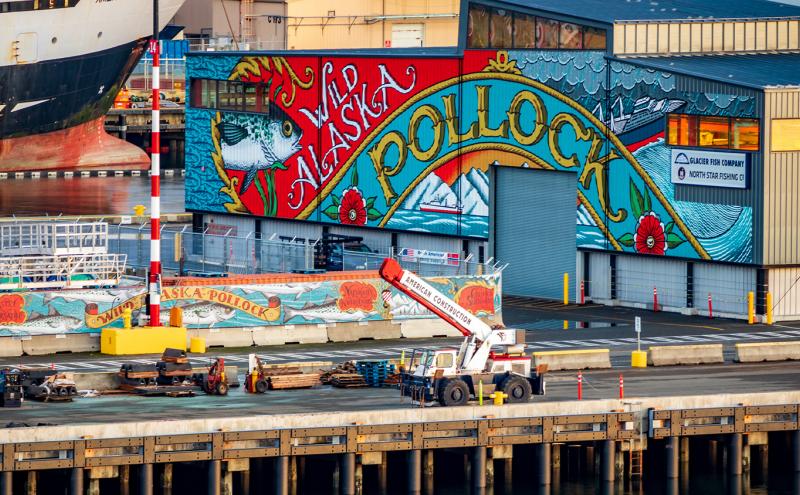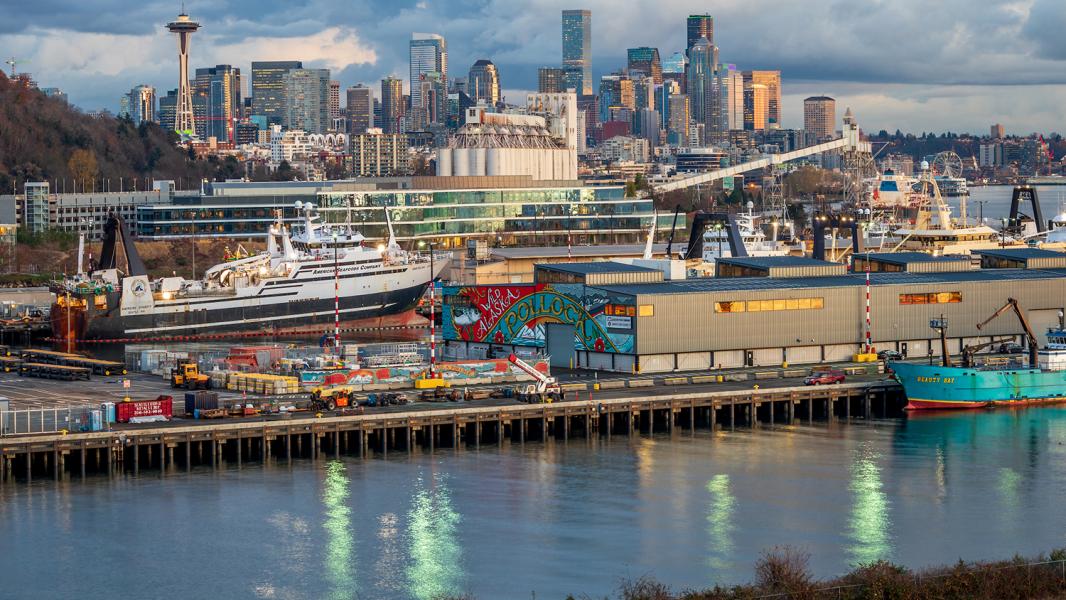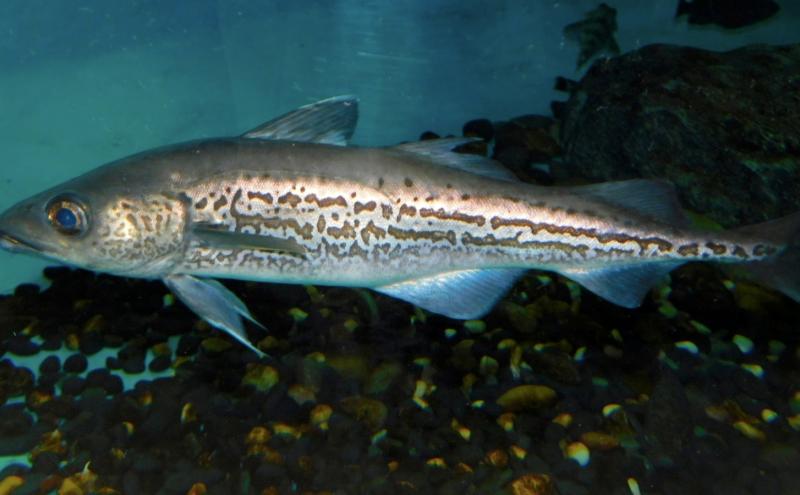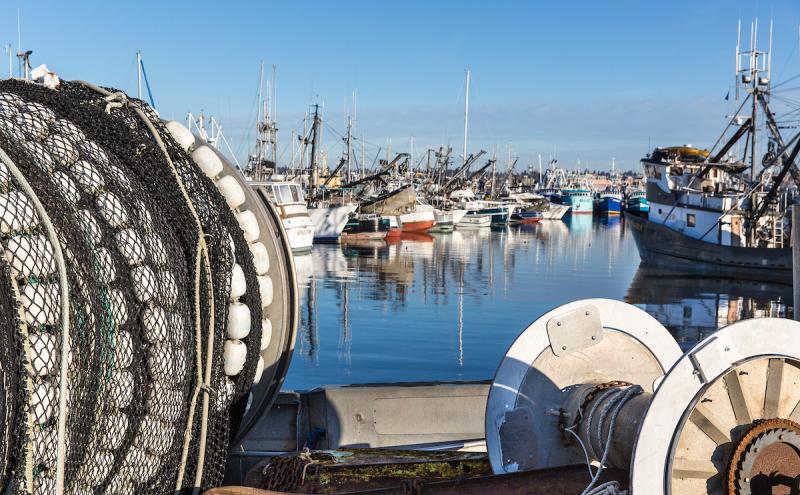
When cruise ships dock at Pier 91 at Smith Cove, passengers will now be greeted with more than a view of surrounding neighborhoods. They will step off the ship to a colorful 100-foot-long mural starring the North Pacific Fishing Fleet’s greatest catch – Wild Alaska Pollock – in an ode to one of the Pacific Northwest’s oldest and thriving industries.
There is much to love about Wild Alaska Pollock, and the mural aims to educate and build interest and excitement for the “World’s Best Whitefish.” Although pollock is caught in the pristine icy waters of Alaska, it has strong ties to the economy and dinner tables in the Pacific Northwest. The mild tasting fish is best known as the main ingredient in fish sticks and surimi, but can be so much more as demonstrated in recipes by local chefs. It's plentiful, healthy, tasty, sustainable, and supports the local commercial fishing economy.
In early 2021, the Genuine Alaska Pollock Producers (GAPP) commissioned the mural by local artist Kyler Martz that highlights the compelling attributes of the amazing but under-the-radar fish. With installation nearly complete, the mural offers a pop of color on grey Seattle days, and runs along the north face of the Glacier Fish Company headquarters at Terminal 91, home to two cruise berths and commercial fishing moorage.
Here’s more about the fishy mural that will capture the hearts and eyes of neighbors and visitors alike:
1. It all started with a blank wall and a little creativity
When GAPP member Glacier Fish Company offered one of its building walls to create something interactive and creative, the creative team at Garrigan Lyman Group (GLG), which supports GAPP’s marketing and branding efforts, seized the opportunity. They got to work brainstorming concepts that would tell the story of the under-the-radar fish to a new audience.
With the chance to reach thousands of cruise passengers each year, and offering a front row view for the nearby Seattle neighborhood of Magnolia, the space promised a captive audience. So GLG sketched out a vision that would promote awareness of the species and pride in the commercial fishing industry.
“This was a chance to create something fun, inspiring, and informative rather than just selling something,” said Ed Ouellette, Senior Strategic Client Manager at GLG.
2. The creative team sought to create something iconic
GLG saw a unique opportunity to create a Seattle landmark. The space they were working with was bigger and more permanent than something like a billboard.
“It’s not every day you can do something like this in such a visible space,” Ouellette said. “We wanted something iconic, that didn’t feel like an ad. We wanted something recognizable and synonymous with Seattle, like the Starbucks siren, the Rainier “R”, or the mural at Cinerama. When a neighbor drives or walks by or a cruise line floats by or docks, they will see something remarkable.”

3. Artist Kyler Martz dazzled the team with his nautical, surrealist style
To start, Ouellette and his team researched local artists whose style might be a good fit for the project. They narrowed the list down to three different artists. Kyler Martz, a muralist, illustrator, and tattooist stood out in the crowd.
“His work has a definitive style,” Ouellette said. “He creates a lot of vintage-inspired, etched pieces, and uses a lot of typographic elements; it’s some super cool stuff. GAPP really gravitated to his work.”
Martz gravitates toward nautical themes in many of his pieces, inspired by living on the water in Seattle. Many of his pieces include contrasting themes or ideas, and this design gives a nod to classic seafood packaging.
You don’t have to go far to bump into Martz’s work in Seattle. His murals are on display at Whale Wins restaurant in Ballard and Ballard PCC Community Markets, and he has created illustrations for the Fremont Solstice Festival, the Amazon Treasure Truck program, Filson, and more.
4. The mural was created with adhesive and polyester mesh, rather than paint
Using these materials allowed for more efficient and flexible installation during the traditionally rainy and windy fall and winter seasons in Seattle.
The mural was installed using lifts, with adhesive similar to those applied to ships or vehicles, specially made to go around rivets and to allow for vibrant and reliable colors. The mural is held in place by a fence made of polyester mesh material that allows for air flow while being reinforced in key areas to ensure it stays where it’s supposed to. Unlike a digital image, everything must be perfect so there is no room for error.
5. Martz combined Wild Alaskan Pollock research with his own twist as he developed the design
“As an artist we knew he would put his own spin on the mural,” Ouellette said.
Martz combined his offbeat style with research and inspiration on the Wild Alaskan Pollock with a backdrop of a fisherman’s journey to Alaska. He worked on several visual approaches that he presented to the GAPP team. The end result blends different aspects of each approach into one design.
“The color choices are pretty powerful,” Ouellette said. “I’m looking forward to when it’s all done to take it all in at once.”
GAPP trusted the artist's process and allowed Martz to take creative license. The result is a stunning representation of the versatile fish, its Alaskan habitat, and the fishermen’s journey to bring the catch back to Seattle.
“I’m so proud of how it's come together,” Ouellette said. “I can’t wait to see how public reacts to it.”
Craig Morris, CEO of GAPP, said the mural powerfully illustrates the story of the amazing fish that is a critical piece of the local commercial fishing economy.
"The vibrancy of the colors in this mural represents the vibrancy of the Wild Alaska Pollock fishery — both its storied past and bright future. This new mural not only serves as a beacon to welcome our fleet back home, but will now be a landmark for residents and visitors alike to get to know one of the greatest stories ever told — the story of the world's most sustainable, nutritious, versatile, and abundant fish: the Wild Alaska Pollock."









